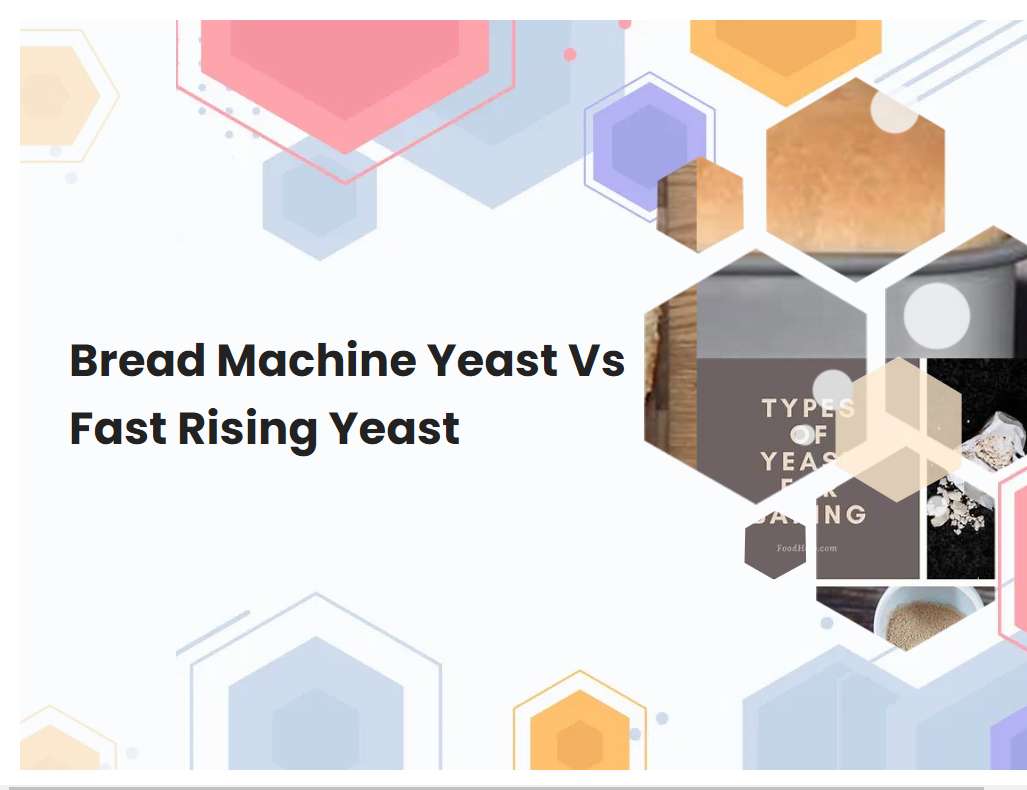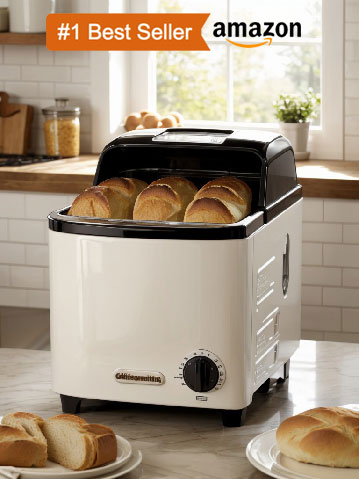Bread Machine Yeast Vs Fast Rising Yeast
Yeast is an essential ingredient in baking that helps dough to rise. Many recipes call for either machine yeast or fast-rising yeast, which are different types of yeast. In this article, we will discuss the difference between machine yeast and fast-rising yeast so you can understand which one is best for your baking needs.

Bread machine yeast is specifically designed for use in bread machines.
Bread machine yeast is specially designed for making bread in a bread machine. It is an active dry yeast, which means that it is composed of tiny granules and needs to be activated in water before it can be used. It is not the same as regular active dry yeast, which is typically used in recipes that call for yeast to be proved or added directly to the dough.
Bread machine yeast is designed to work with the slower kneading process of a bread machine, and it also produces a slightly different flavour than regular active dry yeast. Bread machine yeast is ideal for those who make bread frequently, as it requires less activating time than regular active dry yeast and provides a more consistent result each time.
Fast rising yeast is a type of active dry yeast with a higher concentration of live cells.
Rising to the challenge of baking better bread, rising yeast has quickly become a popular choice for baking enthusiasts. This type of active dry yeast is made up of a higher concentration of live cells than traditional active dry yeast. This higher concentration of cells means that rising yeast is quicker to act and produces dough that rises faster and with more stability.
Rising yeast is an excellent choice for bakers who are in a hurry, as it often cuts rising time in half or more. It is also great for making dough that needs to be kneaded by hand, as the dough will often rise more quickly and with more even results. Rising yeast also produces dough that has better flavor and texture than dough made with traditional active dry yeast. When using rising yeast, it is important to remember that it is more powerful than traditional active dry yeast, so you should use less of it than you would normally. This type of yeast is also not recommended for making doughs that require long rising times, such as sourdough or other slow-rise doughs. Rising yeast can be found in most stores that sell baking supplies and can be a great addition to any baker's arsenal.
See also: How To Make Chelsea Buns In A Bread Machine
Bread machine yeast is finer and dissolves more quickly than fast rising yeast.
Bread machine yeast is a type of yeast specifically designed for use in bread machines. It is finer and more granular in texture than regular dry yeast, and it dissolves more quickly in liquids. This makes it ideal for use in bread machines, where rapid yeast activation is essential.
Bread machine yeast is also capable of withstanding higher temperatures than regular dry yeast, ensuring that it will activate properly even during long baking cycles. It is typically sold in pre-measured packages, making it convenient and easy to use in the home kitchen. Additionally, unlike regular dry yeast, it does not require additional proofing or activation before use.
See also: Instant Yeast To Bread Machine Yeast Conversion
Fast rising yeast requires slightly less rising time than bread machine yeast.
Fast rising yeast is a great choice when baking bread that requires a shorter rising time. It is formulated to produce gas bubbles more quickly than regular bread machine yeast, allowing for a shorter rise time of about half the time it would take for regular yeast. When using fast rising yeast, it is important to note that it can be more sensitive to changes in temperature and humidity.
It should be stored in a cool, dry place and proofed in lukewarm water to ensure that it activates properly. Additionally, when using fast rising yeast, it is important to use less of it than regular bread machine yeast as it is more powerful and can cause the dough to over-rise if too much is used. Overall, fast rising yeast is a great choice for breads that require a shorter rising time as it can be activated quickly and yield delicious results.
See also: Can You Make Scones In A Bread Machine
Bread machine yeast works best for doughs with higher sugar content.
Bread machine yeast is an ideal choice for doughs that contain higher amounts of sugar. This type of yeast is specifically designed to work well with these types of doughs, as it has the ability to activate quickly in the presence of sugar. This helps to ensure that the dough will rise properly and create a light and fluffy texture.
Additionally, bread machine yeast is pre-measured and does not require any additional proofing or activation, making it quick and easy to use. It is also more tolerant than other types of yeast, as it can withstand temperatures up to 130°F, making it suitable for use in bread machines that may have hotter-than-average temperatures. Furthermore, this type of yeast produces a milder flavor than other yeasts, which can be beneficial if you are seeking a sweeter-tasting bread.
See also: Substitute Rapid Rise Yeast For Bread Machine Yeast
Fast rising yeast works best for doughs with lower sugar content.
Rising yeast is a key ingredient in bread making, as it helps the dough to expand and create a soft, fluffy texture. For doughs with a lower sugar content, it's best to use a fast-rising yeast. This type of yeast works quickly and is more tolerant of lower sugar levels.
It can be used in combination with other leavening agents like baking powder or baking soda for an even more efficient rise. Fast-rising yeast also helps keep the dough light and fluffy, even when it's made with a lower amount of sugar. This makes it the ideal choice for doughs that are intended to be sweet but not overly sugary. The downside is that fast-rising yeast requires more attention than regular yeast, so it's important to be aware of its activity and keep an eye on it during the rising process.
See also: How To Make Bread Pudding In A Bread Machine
Bread machine yeast needs to be stored in a cool, dry place.
Bread machine yeast is a type of active dry yeast, which is a type of yeast that must be rehydrated before it can be used for baking. It is specially formulated for use in bread machines and is an essential ingredient in many recipes. To ensure that the yeast remains viable and retains its potency, it must be stored in a cool, dry place.
This means avoiding any areas with excessive moisture or heat, such as near a window or the kitchen sink. It should also be kept away from direct sunlight. An airtight container or resealable plastic bag is ideal for storing bread machine yeast, and should always be kept sealed when not in use. With proper storage, bread machine yeast can last up to two years.
Fast rising yeast needs to be stored in the refrigerator.
Rising yeast is an important ingredient in many baked goods, and its storage is essential for ensuring that it stays viable and effective. Rising yeast should be stored in the refrigerator, away from direct heat and moisture. The cold temperature of the refrigerator slows the yeast's activity, helping it retain its potency and freshness.
It should be kept in an airtight container or plastic bag to prevent moisture from entering and compromising its quality. When adding the yeast to a recipe, it is important to make sure that it is not exposed to temperatures greater than 120 degrees Fahrenheit, as this will kill the yeast. Storing rising yeast in the refrigerator helps to ensure that it remains fresh, making it an ideal choice for baking delicious treats.
Bread machine yeast should be added directly to the dry ingredients.
When using a bread machine, it is important to add the yeast correctly in order to produce the best possible results. Bread machine yeast should be added directly to the dry ingredients when following a recipe. It is important to not mix the yeast with any liquids, as this could cause it to activate too soon and result in an unevenly risen loaf.
Additionally, it is important to use the amount of yeast specified in a recipe, as too much or too little yeast can have a large impact on the quality of the finished product. Once the yeast has been added, it is best to stir it into the dry ingredients to ensure even distribution throughout the dough. Following these steps will help ensure that your bread machine produces a perfect loaf every time.
Fast rising yeast should be dissolved in warm water before adding to the dry ingredients.
When using fast rising yeast in baking, it is important to dissolve the yeast in warm water before adding it to the dry ingredients. This process will help to activate the yeast, resulting in a better rise and flavor in the final product. To begin, measure the amount of yeast indicated in the recipe and add it to a small bowl.
Pour warm water (110-115°F) into the bowl, stirring until the yeast is completely dissolved. Allow the mixture to sit for five minutes before adding it to the dry ingredients. This will help to ensure that the yeast is active so that it can properly leaven the dough, resulting in a delicious and light final product.





